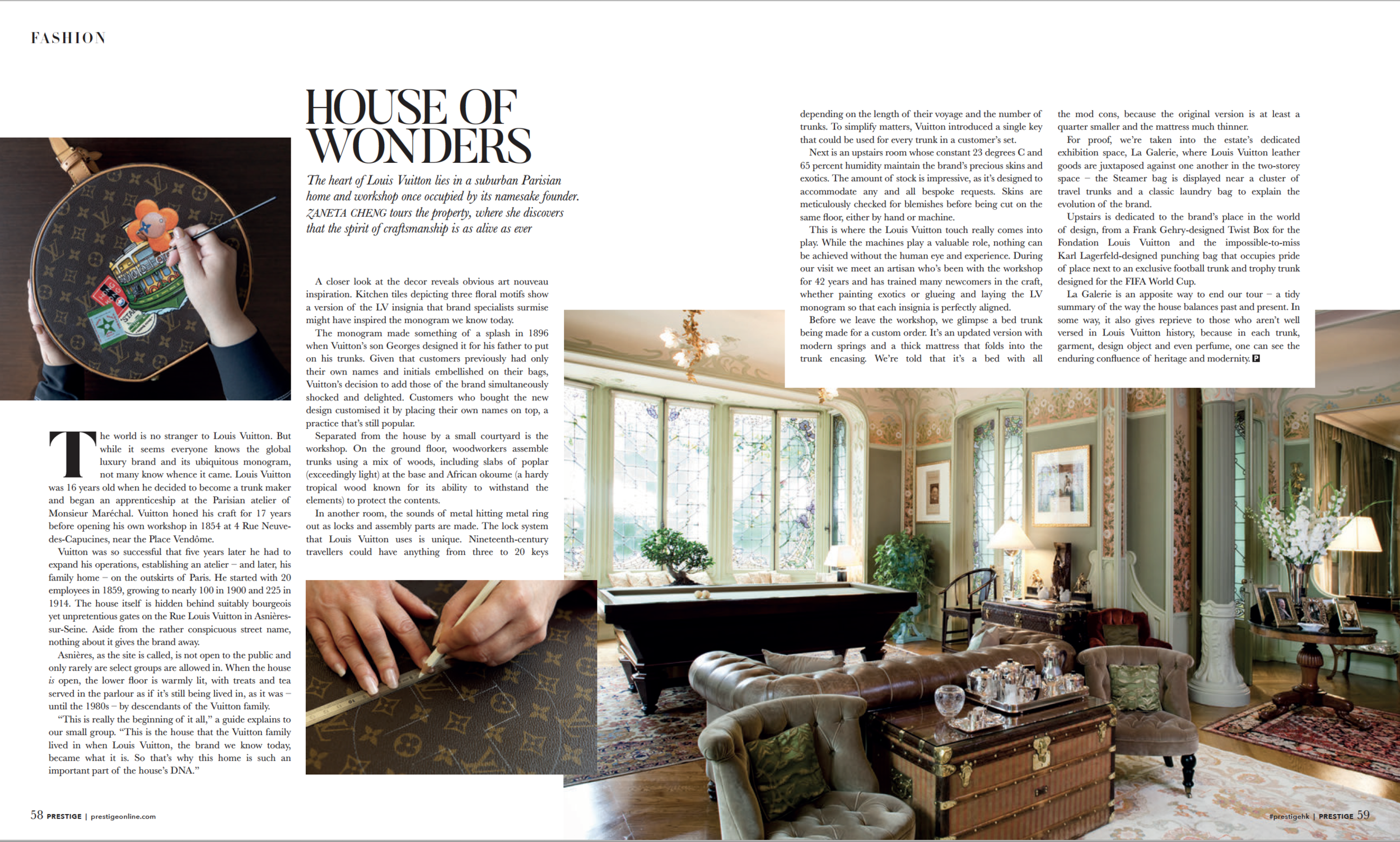Louis Vuitton Asnieres | Prestige Hong Kong (Jun 19)
The heart of Louis Vuitton lies in a suburban Parisian home and workshop once occupied by its namesake founder. zaneta cheng tours the property, where she discovers that the spirit of craftsmanship is as alive as ever
The world is no stranger to Louis Vuitton. But while it seems everyone knows the global luxury brand and its ubiquitous monogram, not many know whence it came. Louis Vuitton was 16 years old when he decided to become a trunk maker and began an apprenticeship at the Parisian atelier of Monsieur Maréchal. Vuitton honed his craft for 17 years before opening his own workshop in 1854 at 4 Rue Neuve-des-Capucines, near the Place Vendôme.
Vuitton was so successful that five years later he had to expand his operations, establishing an atelier – and later, his family home – on the outskirts of Paris. He started with 20 employees in 1859, growing to nearly 100 in 1900 and 225 in 1914. The house itself is hidden behind suitably bourgeois yet unpretentious gates on the Rue Louis Vuitton in Asnières-sur-Seine. Aside from the rather conspicuous street name, nothing about it gives the brand away.
Asnières, as the site is called, is not open to the public and only rarely are select groups are allowed in. When the house is open, the lower floor is warmly lit, with treats and tea served in the parlour as if it’s still being lived in, as it was – until the 1980s – by descendants of the Vuitton family.
“This is really the beginning of it all,” a guide explains to our small group. “This is the house that the Vuitton family lived in when Louis Vuitton, the brand we know today, became what it is. So that’s why this home is such an important part of the house’s DNA.”
A closer look at the decor reveals obvious art nouveau inspiration. Kitchen tiles depicting three floral motifs show a version of the LV insignia that brand specialists surmise might have inspired the monogram we know today.
The monogram made something of a splash in 1896 when Vuitton’s son Georges designed it for his father to put on his trunks. Given that customers previously had only their own names and initials embellished on their bags, Vuitton’s decision to add those of the brand simultaneously shocked and delighted. Customers who bought the new design customised it by placing their own names on top, a practice that’s still popular.
Separated from the house by a small courtyard is the workshop. On the ground floor, woodworkers assemble trunks using a mix of woods, including slabs of poplar exceedingly light) at the base and African okoume (a hardy tropical wood known for its ability to withstand the elements) to protect the contents.
In another room, the sounds of metal hitting metal ring out as locks and assembly parts are made. The lock system that Louis Vuitton uses is unique. Nineteenth-century travellers could have anything from three to 20 keys depending on the length of their voyage and the number of trunks. To simplify matters, Vuitton introduced a single key that could be used for every trunk in a customer’s set.
Next is an upstairs room whose constant 23 degrees C and 65 percent humidity maintain the brand’s precious skins and exotics. The amount of stock is impressive, as it’s designed to accommodate any and all bespoke requests. Skins are meticulously checked for blemishes before being cut on the same floor, either by hand or machine.
This is where the Louis Vuitton touch really comes into play. While the machines play a valuable role, nothing can be achieved without the human eye and experience. During our visit we meet an artisan who’s been with the workshop for 42 years and has trained many newcomers in the craft, whether painting exotics or glueing and laying the LV monogram so that each insignia is perfectly aligned.
Before we leave the workshop, we glimpse a bed trunk being made for a custom order. It’s an updated version with modern springs and a thick mattress that folds into the trunk encasing. We’re told that it’s a bed with all the mod cons, because the original version is at least a quarter smaller and the mattress much thinner.
For proof, we’re taken into the estate’s dedicated exhibition space, La Galerie, where Louis Vuitton leather goods are juxtaposed against one another in the two-storey space – the Steamer bag is displayed near a cluster of travel trunks and a classic laundry bag to explain the evolution of the brand.
Upstairs is dedicated to the brand’s place in the world of design, from a Frank Gehry-designed Twist Box for the Fondation Louis Vuitton and the impossible-to-miss Karl Lagerfeld-designed punching bag that occupies pride of place next to an exclusive football trunk and trophy trunk designed for the FIFA World Cup.
La Galerie is an apposite way to end our tour – a tidy summary of the way the house balances past and present. In some way, it also gives reprieve to those who aren’t well versed in Louis Vuitton history, because in each trunk, garment, design object and even perfume, one can see the enduring confluence of heritage and modernity.
